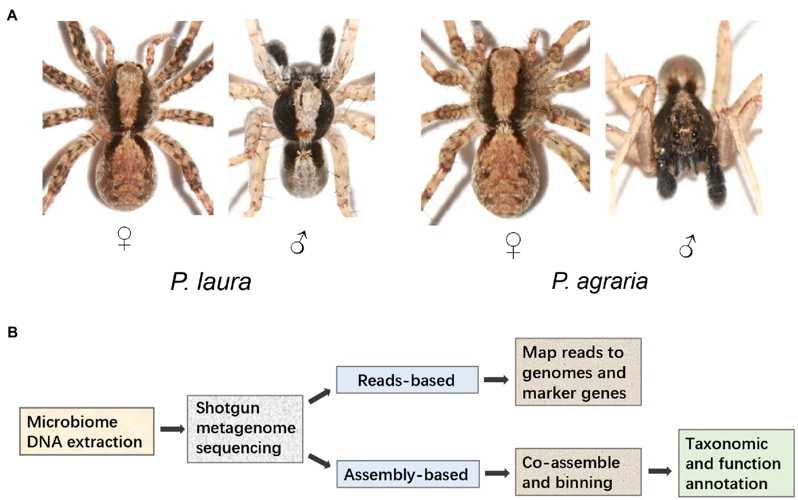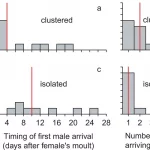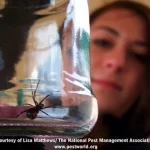Have you ever wondered how scientists identify and classify the different species of wolf spiders? The answer lies in the intricate and meticulous methodology of nomenclature. Nomenclature is the system of naming and classifying organisms and is fundamental to scientific research. In the case of wolf spider research, accurate nomenclature is crucial to distinguish between different species and understand their unique characteristics, habitats, and behaviors. However, challenges in nomenclature can have severe consequences on research studies and conservation efforts. In this article, we will explore the significance of nomenclature in wolf spider research, its current challenges, and the future of this essential scientific practice.
The Basics of Nomenclature
Understanding the basics of nomenclature is crucial in the field of taxonomy as it provides a standardized system of naming and identifying various species. The system of binomial nomenclature, introduced by Carl Linnaeus in the 18th century, is still used today to identify and classify organisms. In the case of wolf spiders, correct nomenclature is key to distinguishing different species, and ensuring accurate identification. Learning about the basics of nomenclature is an essential foundation for any research or fieldwork related to wolf spiders. To delve more deeply into the classification and taxonomy of wolf spiders, check out our article on the classification of wolf spiders, and our guide to naming and identifying wolf spider species. Additionally, for an in-depth look at the taxonomic history of wolf spiders, visit our comprehensive resource on the taxonomic history of wolf spiders, and our guide to the taxonomic key to wolf spiders will be indispensable for anyone identifying wolf spider species.
Why Accurate Nomenclature is Important
Accurate nomenclature is crucial in biological research, especially for species identification and classification. Inaccurate nomenclature can lead to various negative consequences, including:
- Misinterpretation of Research Data: Using incorrect species identification data can lead to incorrect conclusions and misinterpretation of the research. This can potentially mislead the scientific community and potentially impact future research, leading to time and resources being wasted.
- Misdiagnosis and Mismanagement of Diseases: An accurate species identification is important for the diagnosis and treatment of diseases. Incorrect species identification can lead to the misdiagnosis and mistreatment of diseases, potentially endangering the patient.
- Impacts on Ecology and Conservation: Many species are endangered due to habitat loss and other factors. Incorrect species identification can lead to incorrect assessments of population trends and distribution, misguiding conservation efforts and potentially leading to further endangerment of a species.
- Impacts on Agriculture and Food Safety: Accurate species identification is essential in agriculture and food safety, as pests can cause significant damage to crops and carry diseases that can impact human health. Incorrect identification can lead to ineffective pest management and food safety issues, potentially causing economic damage and endangerment to human health.
Accurate nomenclature is critical in scientific research and has far-reaching consequences beyond the scientific community. It is important to ensure that species identification is correctly performed to avoid any potential negative impacts.
The Role of Nomenclature in Wolf Spider Research
When it comes to research, the significance of nomenclature cannot be overstated. This is especially true in the case of wolf spiders, where accurate identification and nomenclature is essential for a variety of reasons.
Table: Ways Nomenclature is Essential to Wolf Spider Research
| Importance of Nomenclature to Wolf Spider Research | Details |
|---|---|
| Classification of species | Correct nomenclature allows researchers to accurately identify different species of wolf spiders and classify them according to their unique characteristics and traits. |
| Comparative analysis | Having accurate nomenclature allows researchers to make valid comparisons between different wolf spider species and analyze similarities and differences. This allows for deeper insights into the behavior and ecology of these spiders. |
| Data sharing | When conducting research, it is essential to share data with other researchers in the same field. By using standardized nomenclature, data can be shared more easily and efficiently, leading to faster and more impactful research. |
| Conservation efforts | Wolf spiders are an important part of many ecosystems and regions. Having accurate nomenclature allows for better conservation efforts that target specific species. This can help to protect their habitats and ensure their survival. |
Without proper nomenclature, wolf spider research would be hindered and the accuracy and validity of results would be negatively impacted. By using standardized and accurate nomenclature, researchers can make more sound conclusions and contribute to a better understanding of these fascinating arachnids.
The Consequences of Misidentification

Misidentifying a wolf spider can have severe consequences for research studies and conservation efforts. It is crucial to accurately identify and label each specimen to ensure that the research is reliable and the conservation efforts are effective. The failure to do so can cause confusion and negative impacts on studying and understanding the population dynamics of these enigmatic creatures. Let’s dig deeper into the consequences of misidentification and how it can impact wolf spider research.
Effects on Research Studies
Accurate nomenclature is of utmost importance in research studies centered on wolf spider species. Misidentification or incorrect naming of a particular species can have severe impacts on the results of a study. Here are some effects of misidentification in research studies:
- Loss of funding: When the research results turn out to be inaccurate or unreliable, it can lead to loss of grants or research funding. The funds may have been provided for a study on a particular wolf spider species, but if the researchers unintentionally or unknowingly work on a different species, the findings are useless and funding agencies may become reluctant to provide more funds in the future.
- Imprecise data: Misidentification of species could mean that all the collected data is incorrect. Researchers may note the number, size, and distribution of a wolf spider species, but if it is discovered later that the spiders were misidentified, the data becomes useless.
- Wasted time and effort: Fieldwork for this kind of research is often time-consuming and exhausting, from capturing the spiders and collecting samples to analyzing and interpreting data. If the misidentified species is found out at the end of a study, it means all the time and effort invested in that study will have been pointless.
- Possible publication retraction: A publication based on misidentification or incorrect nomenclature could get retracted due to the invalidity of the results. This can harm the reputation of the researchers and negatively affect their future career prospects.
Thus, it is essential to have accurate nomenclature while conducting research studies on wolf spiders to avoid such consequences.
Complications for Conservation Efforts
Inaccurate nomenclature can have drastic consequences for conservation efforts aimed at protecting wolf spider populations and their habitats. The use of incorrect species names can lead to misguided conservation plans and policies, as well as the allocation of resources towards less threatened spider populations.
As an example, let’s consider two wolf spider species: Hogna frondicola and Hogna ingens. Hogna frondicola is a relatively common species found throughout the southeastern United States, while Hogna ingens is a much rarer species, restricted to only a few isolated populations. Without accurate nomenclature, conservation efforts could mistakenly be focused on the more common and abundant Hogna frondicola, rather than the threatened Hogna ingens.
Furthermore, mistaken identity can lead to loss of critical habitat for threatened wolf spider populations. If the wrong spider species is identified as threatened, the conservation measures put in place may not be adequate to protect the actual threatened species.
The table below shows some of the conservation complications that can arise due to inaccurate nomenclature in wolf spider research:
| Complications for Conservation Efforts |
|---|
| Misguided conservation plans and policies |
| Allocation of resources towards less threatened spider populations |
| Loss of critical habitat for threatened populations due to mistaken identity |
It is paramount for researchers to prioritize accurate species identification and nomenclature in their studies. Only then can conservation efforts be backed by reliable and precise information.
The Current Challenges in Nomenclature

As scientific research advances, the challenges of taxonomy and nomenclature become increasingly perplexing. The classification and naming of species is a complex process that demands immense attention to detail. The world of wolf spider research is no exception, and currently, researchers are facing several challenges that hinder their efforts to accurately identify and categorize wolf spider species. These challenges can have severe consequences for scientific studies and conservation efforts, underscoring the importance of finding solutions to these problems. Let’s take a closer look at some of the challenges that researchers face in wolf spider nomenclature today.
The Complexities of Species Identification
Species identification is a complex and challenging process in wolf spider research. It requires extensive fieldwork, detailed microscopy, and molecular analysis. The morphological characteristics of wolf spider species are highly variable and can depend on several factors such as age, sex, and environmental conditions. The following table summarizes the complexities of species identification:
| Complexities | Description |
|---|---|
| Uniqueness | Each species is unique: No two spider species are exactly alike, and even within the same species, there can be significant biodiversity. |
| Size Variability | Size and shape variation: Wolf spiders can vary significantly in size and shape, which can complicate identification. |
| Microscopic Features | Morphological features: Identification requires the examination of microscopic morphological features, such as eye arrangement, leg spination, and genitalia. |
| Molecular Markers | Genetic markers: DNA-based techniques, such as barcoding and phylogenetic analysis, are now widely used in species identification. |
| Expertise | Specialization: Accurate species identification requires a high level of taxonomic expertise and experience. |
These complexities can lead to inaccuracies in species identification, which can have significant implications for research studies and conservation efforts. Collaborative research and continued development of more advanced techniques are necessary to improve the accuracy of species identification in wolf spider research.
The Need for Collaborative Research
The field of spider research faces several challenges when it comes to nomenclature, and these challenges can only be addressed through collaborative efforts. Collaborative research is essential for spider experts to share information, skills, and experience in order to make accurate species identifications. To overcome the complexities of species identification, cross-disciplinary research is necessary. This includes collaborations between scientists specializing in taxonomy, genetics, ecology, and behavior.
Cross-disciplinary Research: Collaborations between scientists specializing in taxonomy, genetics, ecology, and behavior are vital for making accurate species identifications. This is because different specialists can provide information and data that can be combined to make more accurate identifications than would otherwise be possible. By working together, researchers can also develop comprehensive species identification guides that rely on multiple diagnostic traits.
- Sharing of Information: Collaborative research allows researchers to share data, information, and knowledge that can help improve species identifications. By pooling information from a variety of sources, researchers can develop a more accurate picture of the distribution and diversity of wolf spiders.
- Skill Sharing: Collaborations between researchers with different skills and expertise provides opportunities to learn and share skills. For example, geneticists can teach taxonomists how to use genetic markers or genome sequencing to enhance species identification.
- Expanded Knowledge Base: Collaborative research expands our knowledge base by bringing together researchers from different backgrounds and perspectives. This can lead to new insights into wolf spider species’ behavior, ecology, and conservation.
Collaborative research in nomenclature is also crucial for an effective conservation strategy. By identifying the correct species, researchers can make sure that their conservation efforts are directed at the correct targets. Misidentifications can lead to conservation efforts that are ineffective or even harmful to a population. Collaborative research can also help identify new species that require conservation attention.
Conservation: Accurate species identification is essential for effective conservation strategies for wolf spiders. Collaborative research can help identify new species and ensure conservation efforts are targeted effectively.
- Effective Conservation Efforts: Correct species identification enables researchers to understand the ecology and behavior of each species, allowing them to develop tailored conservation strategies. For example, if one species is found to be at risk of habitat loss, conservationists can take measures to protect its habitat before it is threatened.
- Avoiding Harmful Interventions: Misidentification can lead to harmful interventions that can further endanger a species. For example, if a spider is falsely identified as an invasive species, efforts can be made to eradicate it even though it is a harmless native species.
- Identifying New Species: Collaborative research can lead to the discovery and identification of new species, which can require immediate action to prevent their extinction.
Collaborative research is essential for understanding and accurately identifying wolf spider species. Researchers from different fields bring different skills, knowledge, and data sets that can be combined to make more accurate identifications. By working together, researchers can also develop comprehensive species identification guides that rely on multiple diagnostic traits. Accurate species identification is also crucial for conservation efforts. Collaborative research ensures that conservation efforts are targeted at the correct species and can identify new species requiring conservation attention.
The Future of Nomenclature in Wolf Spider Research
As the discipline of wolf spider research continues to evolve, so does our understanding of the importance of nomenclature in guiding our explorations. Moving forward, it’s crucial that we stay up-to-date on the latest developments and technologies that will help us more accurately identify and categorize these fascinating creatures. In this section, we’ll explore some of the current challenges facing the field and discuss how ongoing collaboration and new innovations in DNA analysis are helping pave the way to a more comprehensive and nuanced understanding of wolf spider nomenclature.
New Developments in DNA Analysis
The last decade has seen significant advances in DNA analysis technology, which has profoundly impacted the field of taxonomy and nomenclature in wolf spider research. With the advent of Next-Generation Sequencing (NGS), researchers can now analyze and compare massive amounts of genetic data to identify distinct species and to gain a better understanding of species relationships.
Metabarcoding is one such DNA analysis technique that has become increasingly popular in wolf spider research. This method involves amplifying and sequencing DNA from environmental samples, such as soil or water, to identify the species present within a given area. This non-invasive technique has made it possible to conduct comprehensive biodiversity surveys on a large scale and has allowed researchers to gain a better understanding of how wolf spiders fit within their ecosystems.
Another technique that has revolutionized DNA analysis is single-nucleotide polymorphism (SNP) genotyping. This approach utilizes DNA sequencing to identify specific genetic markers that can be used to differentiate between species. SNP genotyping is particularly useful in cases where morphology is unreliable for species identification, as is often the case with closely related wolf spider species.
Lastly, advances in genomic technology have allowed researchers to analyze entire genomes and compare molecular data across species. This technique has not only helped identify new species but has also provided insight into species relationships and the evolution of wolf spiders.
New developments in DNA analysis have provided researchers with powerful new tools to accurately identify species and to better understand their ecological roles. As technology continues to evolve, it is expected that even more advanced techniques will emerge, further enhancing our ability to understand and conserve wolf spider species and their habitats.
| DNA Analysis Techniques | Description |
|---|---|
| Metabarcoding | A non-invasive technique that involves sequencing DNA from environmental samples to identify the species present within a given area. |
| Single-Nucleotide Polymorphism (SNP) Genotyping | Utilizes DNA sequencing to identify specific genetic markers that can be used to differentiate between species, particularly useful when morphology is unreliable for species identification. |
| Genomic Analysis | Allows researchers to analyze entire genomes and compare molecular data across species, providing insight into species relationships and evolution. |
Continued Collaborative Research
One of the key factors to ensuring accurate nomenclature in wolf spider research is continued collaborative research. This involves researchers from different universities and institutions working together to identify and classify wolf spider species.
Benefits of Continued Collaborative Research
Collaborative research allows experts in different areas to pool their knowledge and resources, increasing the accuracy of wolf spider identification. By working together, researchers can:
| Benefit | Description |
|---|---|
| Share expertise | Researchers can share their knowledge of different wolf spider characteristics, habitats, and behaviors, helping to improve identification accuracy |
| Compare data | Collaborating researchers can compare their data on wolf spider populations from different regions, identifying discrepancies, and improving overall classification accuracy |
| Improve collections | The exchange of wolf spider specimens between researchers can help improve the accuracy of museum and university collections, ensuring that spiders are properly identified for future study |
The Challenges of Collaborative Research
While collaborative research presents many benefits, there are also challenges that must be overcome. These include:
| Challenge | Description |
|---|---|
| Geographic distance | Researchers may be located in different parts of the world, making it difficult to share specimens and data in real-time |
| Language barriers | Researchers from different countries may speak different languages, making communication and collaboration more difficult |
| Resource limitations | Not all institutions may have access to the same resources, such as high-resolution imaging equipment or DNA analysis tools, limiting the scope of collaborative research |
Addressing the Challenges of Collaborative Research
To overcome these challenges, continued efforts are being made to facilitate collaborative wolf spider research. Some of the ways in which these challenges are being addressed include:
| Effort | Description |
|---|---|
| Virtual collaboration tools | Researchers can use virtual tools such as video conferencing and online forums to share data and facilitate discussion, reducing the impact of geographic distance |
| Language support | Translation services or bilingual researchers can help bridge the language gap, ensuring that all participants can communicate effectively |
| Resource sharing | Researchers can collaborate to share resources, such as specimens or equipment, helping to ensure that all members of the collaboration have access to the tools they need |
Conclusion
Collaborative research is essential in wolf spider research, ensuring accurate species identification and classification. While there are challenges to overcome, continued efforts to facilitate collaboration will help to improve wolf spider research accuracy and advance the field as a whole.
Conclusion
In conclusion, it is evident that accurate nomenclature is crucial in wolf spider research. The use of precise and standardized naming systems enables researchers to identify and classify species correctly, which is essential for making informed conclusions about population dynamics, behavior, and ecology. It also enables the proper management and conservation of unique species and their habitats.
The consequences of misidentification are far-reaching and can lead to some severe complications in research studies and conservation efforts. Misidentifying species can equally jeopardize biodiversity assessments and diminish the value of research findings.
Despite advancements in technology and collaboration, nomenclature in spider research remains highly challenging, mainly due to species’ morphological similarities, limited research and knowledge, and different established naming systems. There is also the issue of taxonomy experts and research institutions’ unavailability in some regions, creating a need for collaborative research among experts worldwide.
The future of nomenclature in wolf spider research lies in the continued development of DNA analysis techniques. These methods provide a more accurate and reliable way of identifying and classifying species based on their genetic makeup. Collaborative research is also critical to ensure uniformity in naming systems and effective management of species diversity.
In summary, nomenclature provides a basis for communicating about species and their unique characteristics. In wolf spider research, use of precise and standardized nomenclature has a significant impact on the study’s outcomes and management and conservation of unique habitats and species. Its continued development and importance cannot be overemphasized, and we must invest in research efforts aimed at improving and standardizing nomenclature in wolf spider research.
Frequently Asked Questions
1. What is nomenclature?
Nomenclature is a system of assigning names to organisms in a standardized way.
2. How important is accurate nomenclature?
Accurate nomenclature is crucial to correctly identify and study species, understand their relationships with other species, and implement proper conservation measures.
3. What is the significance of nomenclature in wolf spider research?
Nomenclature is key in wolf spider research as there are many similar-looking species that require proper identification, and the manipulation of taxonomy can greatly impact the interpretation of research results.
4. What are the consequences of misidentification in wolf spider research?
Misidentification can negatively affect research studies and conservation efforts by leading to incorrect conclusions and decisions based on faulty data.
5. How do complications in nomenclature affect conservation efforts?
Complications in nomenclature can lead to confusion regarding which species require conservation measures, resulting in potentially harmful decisions for those species.
6. Why is species identification so complex?
Species identification can be complex due to the presence of cryptic species, where distinct species look very similar, or hybridization, where genetic material from different species is mixed.
7. Why is collaborative research needed to improve nomenclature?
Collaborative research allows for the pooling of resources and expertise to accurately identify species, reduce mistakes, and develop standardized methods for nomenclature.
8. What are some new developments in DNA analysis that can improve nomenclature?
New DNA analysis techniques, such as DNA barcoding and next-generation sequencing, can provide more accurate identification and classification of species.
9. How can continued collaborative research improve nomenclature in wolf spider research?
Continued collaborative research can lead to the development of more streamlined and accurate methods of identifying and classifying species, as well as the discovery of new species previously unknown to science.
10. What is the main takeaway regarding the significance of nomenclature in wolf spider research?
The significance of proper nomenclature cannot be overstated, as it underlies all research and conservation efforts involving wolf spiders and other organisms.






